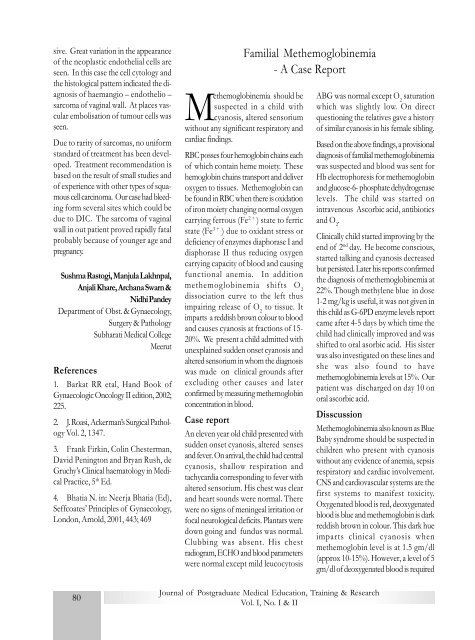Journal 1pages FINAL 34- - National Board Of Examination
Journal 1pages FINAL 34- - National Board Of Examination
Journal 1pages FINAL 34- - National Board Of Examination
You also want an ePaper? Increase the reach of your titles
YUMPU automatically turns print PDFs into web optimized ePapers that Google loves.
sive. Great variation in the appearanceof the neoplastic endothelial cells areseen. In this case the cell cytology andthe histological pattern indicated the diagnosisof haemangio – endothelio –sarcoma of vaginal wall. At places vascularembolisation of tumour cells wasseen.Due to rarity of sarcomas, no uniformstandard of treatment has been developed.Treatment recommendation isbased on the result of small studies andof experience with other types of squamouscell carcinoma. Our case had bleedingform several sites which could bedue to DIC. The sarcoma of vaginalwall in out patient proved rapidly fatalprobably because of younger age andpregnancy.Sushma Rastogi, Manjula Lakhnpal,Anjali Khare, Archana Swarn &Nidhi PandeyDepartment of Obst. & Gynaecology,Surgery & PathologySubharati Medical CollegeMeerutReferences1. Barkat RR etal, Hand Book ofGynaecologic Oncology II edition, 2002;225.2. J. Roasi, Ackerman’s Surgical PathologyVol. 2, 1<strong>34</strong>7.3. Frank Firkin, Colin Chesterman,David Penington and Bryan Rush, deGruchy’s Clinical haematology in MedicalPractice, 5 th Ed.4. Bhatia N. in: Neerja Bhatia (Ed),Seffcoates’ Principles of Gynaecology,London, Arnold, 2001, 443; 469Familial Methemoglobinemia- A Case ReportMethemoglobinemia should besuspected in a child withcyanosis, altered sensoriumwithout any significant respiratory andcardiac findings.RBC posses four hemoglobin chains eachof which contain heme moiety. Thesehemoglobin chains transport and deliveroxygen to tissues. Methemoglobin canbe found in RBC when there is oxidationof iron moiety changing normal oxygencarrying ferrous (Fe 2 + ) state to ferricstate (Fe 3 + ) due to oxidant stress ordeficiency of enzymes diaphorase I anddiaphorase II thus reducing oxygencarrying capacity of blood and causingfunctional anemia. In additionmethemoglobinemia shifts O 2dissociation curve to the left thusimpairing release of O 2to tissue. Itimparts a reddish brown colour to bloodand causes cyanosis at fractions of 15-20%. We present a child admitted withunexplained sudden onset cyanosis andaltered sensorium in whom the diagnosiswas made on clinical grounds afterexcluding other causes and laterconfirmed by measuring methemoglobinconcentration in blood.Case reportAn eleven year old child presented withsudden onset cyanosis, altered sensesand fever. On arrival, the child had centralcyanosis, shallow respiration andtachycardia corresponding to fever withaltered sensorium. His chest was clearand heart sounds were normal. Therewere no signs of meningeal irritation orfocal neurological deficits. Plantars weredown going and fundus was normal.Clubbing was absent. His chestradiogram, ECHO and blood parameterswere normal except mild leucocytosisABG was normal except O 2saturationwhich was slightly low. On directquestioning the relatives gave a historyof similar cyanosis in his female sibling.Based on the above findings, a provisionaldiagnosis of familial methemoglobinemiawas suspected and blood was sent forHb electrophoresis for methemoglobinand glucose-6- phosphate dehydrogenaselevels. The child was started onintravenous Ascorbic acid, antibioticsand O 2.Clinically child started improving by theend of 2 nd day. He become conscious,started talking and cyanosis decreasedbut persisted. Later his reports confirmedthe diagnosis of methemoglobinemia at22%. Though methylene blue in dose1-2 mg/kg is useful, it was not given inthis child as G-6PD enzyme levels reportcame after 4-5 days by which time thechild had clinically improved and wasshifted to oral asorbic acid. His sisterwas also investigated on these lines andshe was also found to havemethemoglobinemia levels at 15%. Ourpatient was discharged on day 10 onoral ascorbic acid.DisscussionMethemoglobinemia also known as BlueBaby syndrome should be suspected inchildren who present with cyanosiswithout any evidence of anemia, sepsisrespiratory and cardiac involvement.CNS and cardiovascular systems are thefirst systems to manifest toxicity.Oxygenated blood is red, deoxygenatedblood is blue and methemoglobin is darkreddish brown in colour. This dark hueimparts clinical cyanosis whenmethemoglobin level is at 1.5 gm/dl(approx 10-15%). However, a level of 5gm/dl of deoxygenated blood is required80<strong>Journal</strong> of Postgraduate Medical Education, Training & ResearchVol. I, No. I & II
















